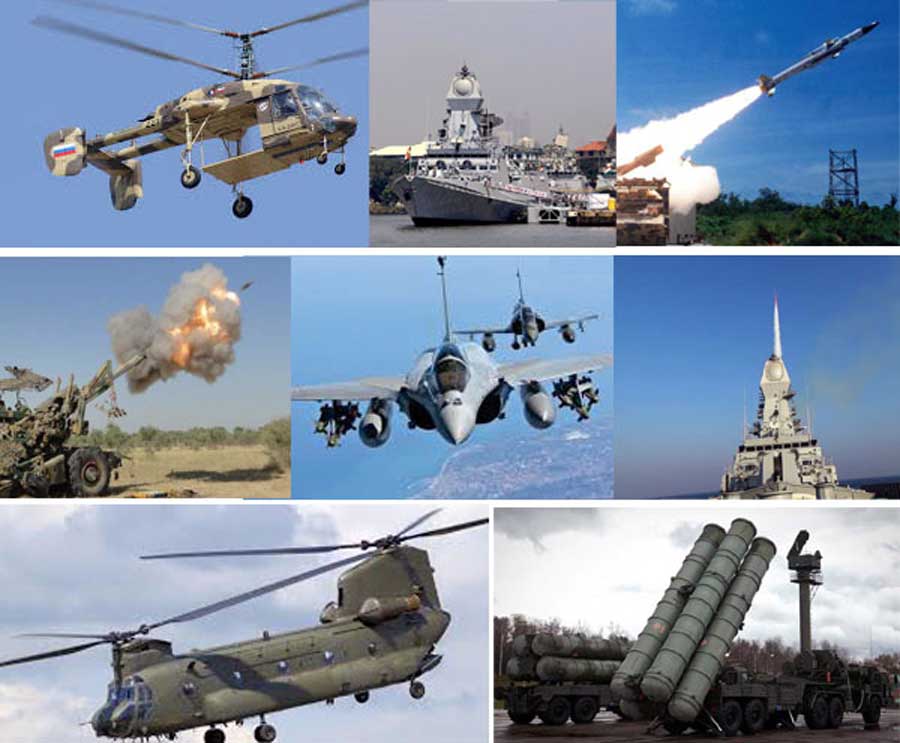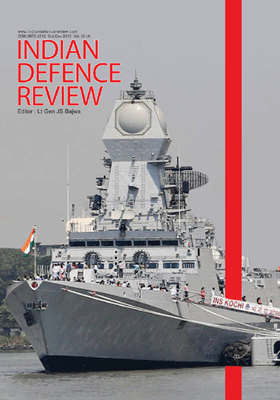Systemic weaknesses and structural shortcomings in India’s national security decision making system have led to sub-optimal synergisation of the available combat resources, meagre as these are. The government must accord the highest priority to the implementation of the recommendations of the Naresh Chandra Committee so that the country’s armed forces are well prepared to meet future threats and challenges and are in a position to contribute positively to security in South Asia and the Indian Ocean Region along with India’s strategic partners.
South Asia is the second most unstable region in the world and is closely vying with West Asia for the number one spot…
South Asia is the second most unstable region in the world and is closely vying with West Asia for the number one spot. Among the world’s major democracies India faces the most complex threats and challenges spanning the full spectrum of conflict from nuclear to sub-conventional. The key geo-strategic challenges in South Asia emanate from the ongoing conflict in Afghanistan and on the Af-Pak border; unresolved territorial disputes between India and China, and India and Pakistan; and, the almost unbridled march of radical extremism that is sweeping across the strategic landscape. The rising tide of Left Wing Extremism (LWE) and the growing spectre of urban terrorism have also contributed towards vitiating India’s security environment.
However, despite the prolonged exposure that the security establishment has had in dealing with multifarious challenges, defence planning has been marked by knee-jerk reactions to emerging situations and haphazard single-Service growth. The absence of a clearly enunciated National Security Strategy, poor civil-military relations, the failure to commit funds for modernisation on a long-term basis and sub-optimal inter-service prioritisation, have handicapped defence planning. With projected expenditure of $100 billion on military modernisation over the next decade, it is now being realised that force structures must be configured on an integrated tri-Service basis to meet future threats and challenges.
Early Efforts Towards Defence Reforms
The Sino-Indian Conflict in 1962 had aroused a new defence consciousness in the country after years of neglect and efforts to formalise defence planning began in 1964. Various organisational changes were tried out:
The rising tide of Left Wing Extremism (LWE) and the growing spectre of urban terrorism have also contributed towards vitiating India’s security environment…
- Defence requirements were assessed on a five-year basis and the First Defence Plan (1964-69) was drawn up.
- A Planning Cell was established in 1965 in the Ministry of Defence (MoD).
- The Second Defence Plan (1969-74) was instituted on a ‘roll-on’ basis. After a year was completed, an additional year was tagged at the other end so that the armed forces would always have a revised and updated five-year plan. This method was found to be impractical.
In 1974, an Apex Group under the Union Minister for Planning suggested that a steady long-term defence effort would be more cost effective and economical than fluctuating allocations on account of periodic economic and security crises.
Structures for Defence Planning: Most of the defence planning machinery and planning methodology were developed in the decade 1964-1974:
- In order to integrate defence planning within the overall economic planning effort, defence and economic development plans were made co-terminus.
- The Committee for Defence Planning (CDP) was established under the Cabinet Secretary.
- The Joint Intelligence Committee (JIC) was constituted in the Cabinet Secretariat to provide external and internal threat assessments.
- Planning Units were also established in the Department of Defence Production and Defence Research and Development Organisation (DRDO).
- A Planning and Coordination Cell was created in the MoD to coordinate and compile various plans into a comprehensive ‘Defence Plan’ for Cabinet approval. However, generalist civilian bureaucrats in the MoD lacked the necessary expertise to arbitrate between the Services and only succeeded in appending together the different requirements of individual Services without any analysis.
- In the Services HQ, Perspective Planning Directorates were established in the late 1970s.
- In 1986, the Directorate General of Defence Planning Staff (DG DPS), comprising officers from the three Services, DRDO, MoD and the Ministry of External Affairs, was constituted to coordinate and harmonise defence planning under the Chiefs of Staff Committee (COSC).
The absence of a clearly enunciated National Security Strategy and the failure to commit funds for modernisation on a long-term basis have handicapped defence planning…
Weaknesses: While efforts have been made to improve defence planning and suitable structural changes have been instituted within the MoD, implementation of the process continues to be tardy.
Guidance. The CCS, chaired by the PM, meets as often as necessary to review emerging situations with adverse impact on national security so as to issue suitable policy directives. However, the National Security Council (NSC), also chaired by the PM, whose charter it is to evolve an integrated national security strategy and provide guidance for long-term defence planning, seldom meets.
Plans. Five-year defence plans are rarely accorded formal government approval. The Tenth Defence Plan (2002-07) and the Eleventh Defence Plan (2007-12) were not approved at all and drifted along on an ad hoc basis.
Funding. Annual defence budgets, in which funds are committed only for one year at a time despite five-year defence plans having been in vogue for several decades, add an element of uncertainty to the planning process. Unutilised funds continue to lapse at the end of the financial year.
Coordination. The absence of an empowered CDS is a glaring anomaly. The COSC works on the basis of consensus and is unable to agree on inter-service priorities for force structuring and modernisation as every Service wants a larger share of the pie. The Services HQ makes its own assumptions of the likely military strategy for future wars and plans its force structures accordingly. Consequently, the LTIPP is integrated merely in name and is actually only a compilation of single-Service plans.
The absence of an empowered CDS is a glaring anomaly…
Defence Acquisition. Despite the much-trumpeted reform in the procurement process, the acquisition of new weapons and equipment by the armed forces is still mired in bureaucratic red tape.
Defence R&D. There is a dichotomy between the time consuming quest for technological self-reliance and the desire of the Services to import arms and equipment based on immediate operational exigencies. The disconnect in the interface between R&D, production agencies and users remains unresolved. As a result, ‘Make’ or ‘Buy’ decisions are still contentious and DRDO projects continue to be delayed with consequent cost overruns.
Recent Efforts
The only time a serious security review was undertaken in the recent past was after the Kargil conflict of 1999 when the Kargil Review Committee (KRC) headed by the doyenne of Indian strategic thinkers, the late K Subrahmanyam, was appointed. The committee was asked to “…review the events leading up to the Pakistani aggression in the Kargil District of Ladakh in Jammu & Kashmir and to recommend such measures as are considered necessary to safeguard national security against such armed intrusions.” Besides K Subrahmanyam, who was appointed Chairman, the Committee consisting of three members – Lieutenant General K.K Hazari (Retd.), BG. Verghese and Satish Chandra, Secretary, National Security Council Secretariat (NSCS) who was also designated as Member-Secretary.
‘Make’ or ‘Buy’ decisions are still contentious and DRDO projects continue to be delayed with consequent cost overruns…
Though it had been given a very narrow and limited charter, the KRC looked holistically at the threats and challenges and examined the loopholes in the management of national security. The Committee was of the view that, “The political, bureaucratic, military and intelligence establishments appear to have developed a vested interest in the status quo.” Consequently, it made far reaching recommendations on the development of India’s nuclear deterrence, the management of national security, intelligence reforms, border management, the defence budget, the use of air power, counter-insurgency operations, integrated manpower policy, defence research and development, and media relations. The Committee’s report was tabled in Parliament on February 23, 2000.
The Cabinet Committee on Security then appointed a Group of Ministers (GoM) to study the Kargil Review Committee report and recommend measures for implementation. The GoM was headed by the Deputy PM and Home Minister L.K Advani and included Defence Minister George Fernandes, External Affairs Minister Jaswant Singh, Finance Minister Yashwant Sinha and National Security Adviser Brajesh Mishra. In turn, the GoM set up four task forces on intelligence reforms, internal security, border management and defence management to undertake in-depth analysis of various facets of national security management. These were headed, respectively, by Jammu and Kashmir Governor G.C Saxena, former Defence and Home Secretary and Principal Secretary to the Prime Minister N.N Vohra, former Home Secretary Madhav Godbole and Arun Singh, former Union Minister who was then Advisor to the Ministry of External Affairs on security matters and who had himself headed the Committee on Defence Expenditure in the early 1990s.
The GoM recommended sweeping reforms to the existing national security management system. The CCS accepted all its recommendations, including one for the establishment of the post of the Chief of Defence Staff (CDS) which has still not been implemented. The CCS approved implementation of the following key measures:
A CDS is yet to be appointed – ostensibly because political consensus has been hard to achieve…
- The post of Chief of Defence Staff (CDS), whose tasks include single-point military advice to the government, inter-services prioritisation of defence plans and improvement in jointmanship among the three Services. However, a CDS is yet to be appointed – ostensibly because political consensus has been hard to achieve and there are differences among the three Services on whether or not a CDS is necessary. The NDA government has once again stated that it will strive to achieve political consensus on the appointment of a CDS.
- Headquarters Integrated Defence Staff (IDS) was established with representation from all the Services.
- A tri-Service Andaman and Nicobar Command and a Strategic Forces Command were established.
- The tri-Service Defence Intelligence Agency (DIA) was established under the Chiefs of Staff Committee (CoSC) for strategic threat assessments.
- Speedy decision making, enhanced transparency and accountability were sought to be brought into defence acquisitions. Approval of the Defence Procurement Procedure (DPP 2002) was formally announced. The DPP has been amended several times since then.
- As part of the DPP, the Defence Acquisition Council (DAC) and the Defence Technology Board, both headed by the Defence Minister, were constituted.
- Implementation of the decisions of the DAC was assigned to the Defence Procurement Board (DPB).
- The National Technical Research Organisation (NTRO) was set up for gathering electronic and other technical intelligence.
- The CCS also issued a directive that each of India’s land borders with different countries be managed by a single agency like the Border Security Force. The concept of “One Border, One Force” was adopted.
- The CCS nominated the Central Reserve Police Force (CRPF) as India’s primary force for counter insurgency operations. This experiment has not yet fully succeeded as the CRPF is taking inordinately long to settle down in its new role as a counter insurgency force.
- The establishment of a National Defence University was approved.
Decision making is gradually becoming more streamlined. The new Defence Planning Guidelines have laid down three inter-linked stages in the planning process:
- 15 years Long Term Integrated Perspective Plan (LTIPP), to be drawn up by HQ IDS in consultation with the Services HQ and approved by the DAC.
- Five-year Defence Plans for the Services (current 12th plan: 2012-2017), including five-year Services Capital Acquisition Plan (SCAP), to be drawn up by HQ IDS in consultation with the Services HQ and approved by the DAC.
Annual Acquisition Plan (AAP), to be drawn up by HQ IDS and to be approved by the DPB. Budgetary allocations for ensuing the financial year (ending March 31st) are made on the basis of the AAP.






